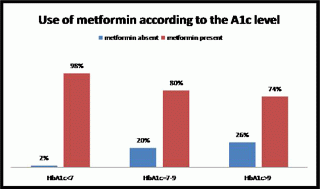ECE2014 Poster Presentations Diabetes (epidemiology, pathophysiology) (63 abstracts)
Profile of type 2 diabetic patients according to HbA1c tertiles in our tertiary health care center
Banu Sarer Yurekli & Gokcen Unal Kocabas
Bozyaka Education and Research Hospital, Endocrinology, Izmir, Turkey.
Aim: In this study we aimed to investigate general properties and treatment modalities of our type 2 diabetic patients.
Materials and methods: A total of 136 consecutive type 2 diabetic patients were investigated. Type 2 diabetic patients were divided into three different groups according to HbA1c level (<7% group 1, 7–9% group 2, >9% group 3).
Results: Mean age of our type 2 diabetic patients (F n=95, M n=41) was 54 years. A1c level of 68% of patients was above 7%. Mean duration of diabetes was 89, 135, and 127 months in group 1,2,3 respectively. Systolic and diastolic blood pressure values were not different significantly. Triglyceride (TG) level was lower in group 1 (P<0.001). HDL level was higher in group 1 when compared to group 3 (P=0.011). CRP was higher in group 3 compared to group 1 (P=0.004). Twenty-six percent of our patients were not using metformin. According to the subgroups, 26% of group 3, 20% of group 2 and 2% of group 1 were not taking metformin (P=0.009) (Fig. 1). Four percent of our type 2 diabetic patients were only on diet treatment. While 53% of them were taking oral antidiabetic (OAD) medication, 43% were on insulin treatment. Percentage of thiazolidinedione use was 15%, DPP-4 inhibitor usage was 20%. Vascular complication rate was higher in group 3 (P=0.019).
Conclusion: Our low percentage of target A1c level could be due to diabetic patients with new onset and relatively short duration of diabetes. As A1c level increases, percentage of vascular complication increases. Relatively high percentage of metformin nonuser in group 3 is quiet remarkable finding. At this point, drug side effect, compliance, and physician related factors should be re-evaluated.

 }
}



